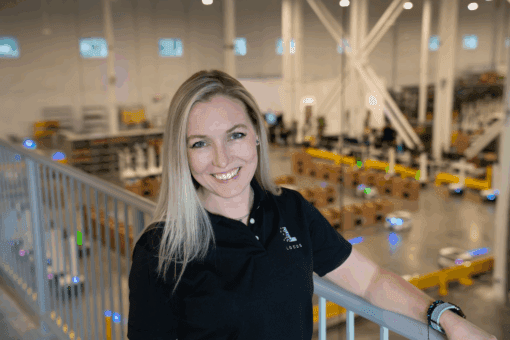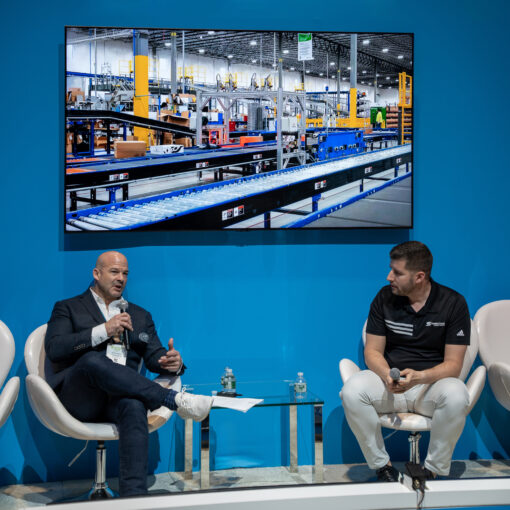WP: How to achieve 400 UPH with Locus Fast Pick
WP: How to achieve 400 UPH with Locus Fast Pick Download Now!
Why Warehouse Agility Wins: The Case for Flexible Automation
Kait Peterson, Vice President and Head of Marketing

The past few years have reinforced that disruption can come from anywhere, including natural disasters, economic shifts, viral product trends, or labor shortages. Warehouses that prioritized flexibility have succeeded and will continue to do so because they can adjust their operations dynamically while maintaining efficiency and throughput.
Warehouse operators face mounting pressure to keep pace with shifting consumer demands, unpredictable supply chain disruptions, and evolving workforce expectations. The ability to scale up or down seamlessly and adapt to dynamic workflows offers a competitive advantage and the way to continue operations through any business change. That’s where automation comes in.
During a recent episode of Warehouse Automation Matters, I had the opportunity to explore how flexible automation solutions empower warehouses to respond to challenges with agility while driving unlimited throughput.
Why Flexibility Is Critical for Warehouse Operations
Warehouses today don’t have the luxury of standing still. One day, an operation might be handling steady volumes, and the next, it could be navigating a surge driven by viral trends or peak season demands. Automation provides the flexibility to adapt to these shifts without costly infrastructure changes.
There are several dimensions to flexibility in a warehouse setting:
- Space Utilization: Optimizing how inventory is stored, picked, and moved is crucial. Solutions like multi-level mezzanines and high-density storage help maximize every square foot.
- Scalability: Some operations need to ramp up for seasonal peaks but don’t want to be locked into fixed automation that sits idle during slower months. Mobile robots offer a way to increase capacity without overinvesting in permanent infrastructure.
- Labor Optimization: Today’s warehouses are battling labor shortages and also adapting to new workforce expectations. Many associates today prefer roles that minimize repetitive manual tasks and incorporate technology to improve productivity.
Automation That Works with Warehouse Workflows
Automation isn’t about replacing human associates — it’s about enhancing efficiency, reducing strain, and making operations more resilient. One key example of this is how automation can support high-velocity picking.
Take fast pick technology as an example. Instead of requiring every item to be sorted and stocked before fulfillment, fast pick automation allows for direct picking from inbound pallets. This minimizes handling, speeds up fulfillment, and reduces unnecessary labor costs to turn a warehouse into a dynamic fulfillment engine that can quickly respond to demand spikes.
Another example is adaptive fleet deployment where warehouses no longer need to commit to a fixed fleet size. With flexible automation, they can bring in additional mobile robots as demand rises, then scale back when order volumes decrease. This ability to shift in real-time is a game-changer for third-party logistics providers (3PLs) and retailers managing ever-changing inventory needs.
Beyond Efficiency: The Role of Intelligent Warehousing
While automation is a powerful tool for improving efficiency, its real value comes from the data it generates. Every pick, every movement, and every completed order provides insights that help warehouses refine their operations.
Key metrics like units per hour (UPH) and order cycle times are foundational, but automation unlocks deeper insights:
- Mission time analysis: How long does it take from receiving an order to fulfilling it? Where are the bottlenecks?
- Accuracy tracking: How well are workers adhering to optimized workflows?
- Inventory flow optimization: Where does stock need to be positioned for the most efficient picking?
Intelligent automation platforms collect and analyze this data in real-time, allowing warehouse managers to make informed decisions that continuously improve efficiency.
Common Misconceptions about Warehouse Automation
Despite the clear advantages, some misconceptions still hold warehouse operators back from adopting automation. A few of the most common ones include:
- "Automation is only for large, high-volume warehouses." In reality, automation is scalable. Mobile solutions can be deployed in facilities of any size, from small distribution centers to multi-level, million-square-foot warehouses.
- "Once automation is in place, it’s fixed." Unlike traditional automation that relies on bolted-down conveyor belts, mobile robots and flexible automation solutions can adjust to new workflows and facility layouts with ease.
- "Automation eliminates jobs." Instead, it shifts the nature of work. Automation reduces repetitive, physically demanding tasks, allowing workers to focus on higher-value activities such as inventory management and quality control.
What’s the Future of Warehouse Operations?
The warehouses of the future will be defined by their ability to adapt. Labor markets will continue to evolve, demand will remain unpredictable, and pressure to maximize throughput will only increase. Investing in flexible automation is about keeping up with and staying ahead of changing business needs.
Warehouse operators should consider:
- Where their business will be in the next five years and whether their current processes allow for growth and change.
- How quickly they can scale automation solutions without disrupting existing operations.
- Which technology partners have a proven track record in warehouse automation—not just in building robots, but in deeply understanding the complexities of warehouse operations.
By embracing automation that prioritizes flexibility and throughput, warehouses can achieve greater efficiency without sacrificing adaptability.
To hear more insights on this topic, listen to my full conversation on the Warehouse Automation Matters podcast.
BIO:
Kait Peterson is an experienced leader in supply chain marketing currently serving as the Vice President of Product Marketing at Locus Robotics, where she shapes the global product marketing strategies, leads market intelligence, and drives go-to-market initiatives. With over a decade in supply chain technology and a background in global marketing and program management, Peterson previously led commercial integration and marketing transformation at Kaleris and Navis. Peterson also held prominent roles at Blume Global and Körber Supply Chain, overseeing global marketing and driving key strategic initiatives. Peterson holds an International MBA and has certifications in supply chain management, DEI, and marketing analytics. Beyond work, Peterson enjoys reading, outdoor activities, global travel and has a keen interest in Stoic philosophy and ancient history.




